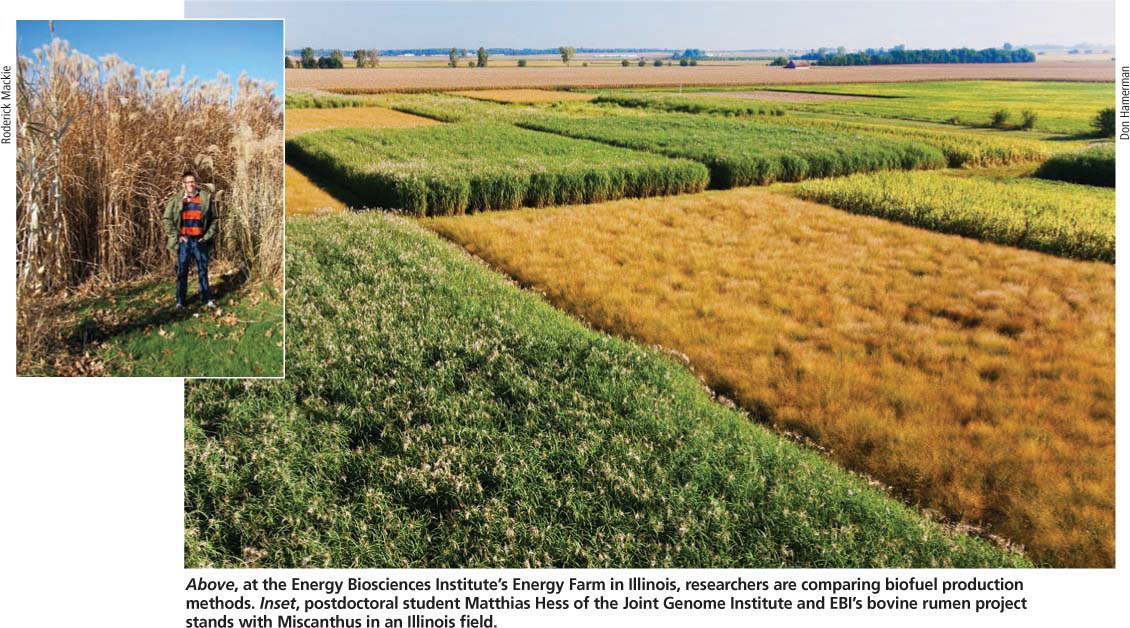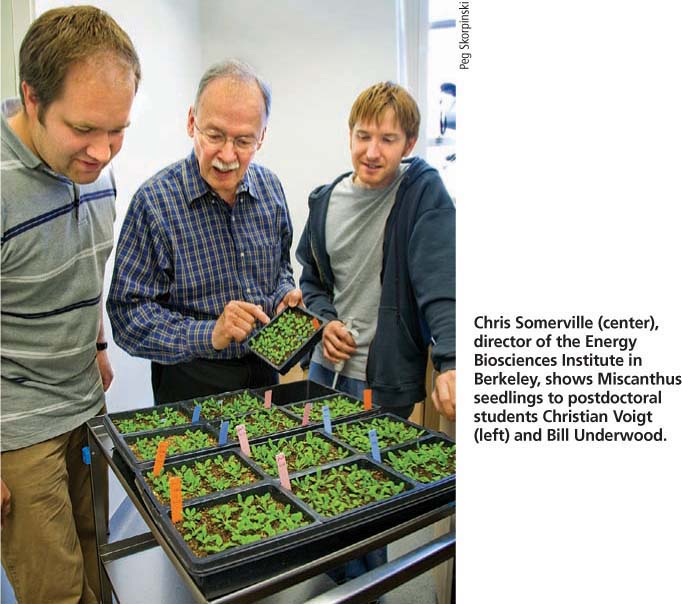All Issues
Dozens of UC research projects pursue fossil-fuel alternatives: Energy Biosciences Institute seeks renewable, sustainable, environmentally friendly biofuels
Publication Information
California Agriculture 63(4):165-167.
Published October 01, 2009
PDF | Citation | Permissions
Full text
Now completing its second year of a 10-year funding commitment from the energy company BP, the Energy Biosciences Institute (EBI) finds itself a central player in the international network of scientists looking for sustainable, renewable, environmentally friendly alternatives to transportation fossil fuels. With headquarters in Berkeley and a satellite unit at the University of Illinois, EBI has launched 51 different research projects in an effort to develop an integrated, holistic understanding of the energy biosciences. Cellulosic biofuels, prime targets in the EBI mission, are unusually complex and involve research questions not only in the production area ( see pages 178 and 185 ) but also concerning social and economic impacts on other regions and nations.
“No miracles are required to develop cost-effective cellulosic biofuels,“ says Chris Somerville, UC Berkeley plant scientist and EBI director. “A series of two-fold improvements in the efficiency of various steps could make biofuels less expensive than liquid fossil fuels.”
However, implementing rational improvements in the overall process is challenging. Managing the various components will require coordinated, integrated knowledge from many scientific and engineering disciplines. This is what EBI was established to do, and scientists at UC Berkeley, Lawrence Berkeley National Laboratory (LBNL), and University of Illinois are heavily into the collaborative quest. This fall, another call for proposals was issued by EBI, and 10 to 15 additional programs or projects will be under way by 2010. BP has pledged $500 million for a decade of research.
Other major UC participants in the search for biofuels include EBI's neighbor to the north, the Joint BioEnergy Institute (JBEI) in Emeryville, as well as the California Biomass Collaborative and the Bioenergy Research Center, both based at UC Davis, and the San Diego Center for Algae Biotechnology at UC San Diego ( see box, page 163 ).
Research questions
EBI is interested in addressing three main questions. First, how much land can be used sustainably for cellulosic fuel production around the world without negatively affecting food production or the environment? Second, which types of plants can be used for energy, how can they be grown sustainably with minimal inputs, and how can they be harvested, stored and transported to the point of utilization? And third, what are the most efficient ways of converting cellulosic biomass to liquid fuels?
“This involves a broad investigation of how various types of organisms — ranging from those found in compost heaps to the complex systems in termite guts and cow rumen — degrade biomass,” Somerville says. “Work is also proceeding on new chemical catalysts that can convert the components of biomass to novel fuels.”
In each of five primary work areas, EBI has established interactive teams, which now total more than 130 faculty members and 160 graduate students, postdocs and undergraduates.
Feedstocks.
It begins with the feedstocks, those crops that will provide the biomass from which fuels can be developed. Relying greatly upon a 320-acre “energy farm” near the Urbana-Champaign campus in Illinois, agronomists are searching for the ideal plant that will provide high productivity with a minimum of inputs. Further, the feedstock should involve no displacement of food crops, no major water requirements and a reduction in net greenhouse-gas emissions.
Scientists are looking for better ways to convert plant sugars into fuel, by utilizing organisms and enzymes that can efficiently degrade cell walls. Above, UC Berkeley undergraduate researcher Valerie Chan works in the Calvin Laboratory, where three Energy Biosciences Institute projects are under way.
Above, at the Energy Biosciences Institute's Energy Farm in Illinois, researchers are comparing biofuel production methods. Inset, postdoctoral student Matthias Hess of the Joint Genome Institute and EBI's bovine rumen project stands with Miscanthus in an Illinois field.
One species receiving particular attention is a perennial grass called Miscanthus, whose 70% solar conversion rate is 60% more productive than corn, from which ethanol is currently made.
“Miscanthus also possesses a root system that binds the soil and prevents erosion while providing nutrients to the plant, high productivity in temperate climates and sustainability via carbon sequestration,” says EBI deputy director Steve Long, who oversees the Institute's agronomy program in Illinois. Researchers are modeling Miscanthus for solar radiation, water content and soil depth to predict yields under varying conditions.
Fuel conversion.
Once the optimal feedstock has been identified for a particular region, the hard work begins — converting the cellulose-based plant material into fermentable sugars on a commercial scale. EBI is attacking the problem on several fronts: the discovery and characterization of fungi and thermophiles that produce new enzymes for lignin and cellulose deconstruction; protein engineering and kinetic modeling of improved enzymes; new organism discovery and cellular engineering for enhanced biofuel production and improved tolerance of the biofuel product; and bioprocess engineering to optimize fermentation.
In Berkeley, for example, teams are collaborating on understanding the mechanisms of Neurospora crassa, a model fungus that breaks down woody fiber, and the way its enzymes, transporters and regulators function. The excellent genetic resources available in N. crassa have allowed the researchers to undertake a systematic analysis of what each gene contributes to biomass degradation. Another set of researchers is probing the digestive properties of microbes found in the stomach of cows, in search of enzymes that might be produced or engineered for commercial application. And other groups are probing the physical, biological and chemical basis for the enzymatic activity.
Lignin, the complex binding compound in plant cells that can constitute up to 30% of the cellulosic biomass, is especially problematic for deconstruction. Through imaging and chemical analysis, EBI scientists are studying nature's unique systems in hopes that chemical reactions can be discovered to undo what the millennia have evolved.
Biofuel production.
Then there is the actual biofuel production, by methods such as fermentation — the basic practices used to make beer and wine — and chemical transformations. EBI is exploring several options in parallel. One is using the techniques of systems biology to characterize new types of microbes and by testing genetic modifications of promising organisms. This involves researching chemical and fermentation routes to products more hydrophobic than ethanol and butanol. The investigation of the pathways that will lead to the large-scale production of high-density fuels involves the development of new genetic analysis tools, the study of single-cell gene expression and genome-scale modeling.
EBI is also addressing nonbiological approaches to deconstructing biomass and converting the products into biofuel alternatives. One idea is the potential use of ionic liquids — salts containing organic cations — to dissolve virtually all cellulosic components of biomass at or near room temperature. Upon hydrolysis, the glucose produced can be converted to a variety of products by combinations of acid and metal catalysts.
“Early research results indicate that the option is certainly worth pursuing, either as a stand-alone chemical process or in conjunction with biological methods,” says UC Berkeley chemical engineer Alex Bell, who heads the biofuel chemistry team.
Exploring ecosystem impacts
Global impacts.
Meanwhile, dozens of researchers are working to understand the potential environmental, economic and societal impacts of meeting a growing portion of the world's energy needs through cellulosic or algal biofuels. They are working to understand how land is used around the world, and to model the impacts of growing bioenergy crops on current cropland that is not used for food production, or land that provides key ecosystem services such as carbon storage or biodiversity ( see pages 191 and 202 ).
One team is using five models to conduct geospatial analysis, bioenergy crop modeling and agroeconomic analysis around the globe. One of the first tasks is looking at marginal lands, which are prospective targets for growing Miscanthus and other feedstocks. They are exploring new and better modeling techniques by assimilating the elements of existing systems. The decision support tools that emerge will help to identify prioritized land based on crop value, pasture value and the optimization of soils.
Another team is studying the entire life cycle of a biofuel, to provide models of greenhouse-gas emissions and realistic numbers for each stage of development and use, all of which will result in human health and ecosystem impacts. “The overarching metric is money — the total cost of ecosystem services and environmental impacts,” says UC Berkeley environmental engineer Arpad Horvath, whose team is analyzing the entire life cycle of a biofuel. He said metrics will be developed for human health, natural environments, natural resources, human-made environments and life-support systems.
Economics and policy.
World economics is another area of intense study. The price of energy is extremely flexible, and future biofuel pricing will be dependent on imports and exports of fuel, corn and oil costs, demand for foreign oil, and government mandates and standards. With this much volatility in the market, fiscal viability for processors and growers becomes difficult.
EBI groups are closely watching two policies that will affect the future of biofuels: the federal Renewable Fuels Standard, which requires 36 billion gallons of biofuel to be blended with gasoline by 2022, and the state Low Carbon Fuel Standard, which calls for a reduction of at least 10% in the carbon intensity of California's transportation fuels by 2020. EBI researchers will evaluate the impacts of these policies on the economics of the energy sector and the environment.
Microorganism biology
One other area of interest was added to the EBI portfolio in 2009. Significant populations of microorganisms are found in both coal and petroleum reservoirs deep underground. These microbial populations can be potentially positive influences, with activities such as altering the porosity of the reservoirs, allowing the more efficient recovery of oil. Studies are under way to characterize the organisms found in various reservoirs using the tools of modern biology.
Chris Somerville (center), director of the Energy Biosciences Institute in Berkeley, shows Miscanthus seedlings to postdoctoral students Christian Voigt (left) and Bill Underwood.
“By understanding the genomics of the reservoir microbes, it may be possible to infer how their activities can be better controlled toward useful purposes,” says LBNL senior earth scientist Terry Hazen. Initial research in what is called Microbially Enhanced Hydrocarbon Recovery (MEHR) has begun in a demonstration injection well in Decatur, Ill.







